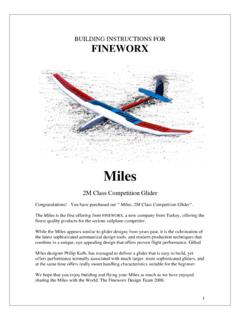Transcription of Army-Tactical Engagement Simulation System (A-TESS)
1 Army-Tactical Engagement Simulation System (A-TESS) Industry Day 6 & 7 March 2012 Agenda (Day 1) Time 0830-0845 0845-0900 0900-1015 1015-1045 1045-1100 1100-1200 1200-1300 1300-1400 1400-1500 1500-1530 Subject Opening Remarks and Introductions PM TRADE & PM LTS Remarks A-TESS Vision/Future of MILES TCM-L Remarks/A-TESS & T-IS CDD Process Break A-TESS Future Capabilities Lunch Standards/Testbeds/Embedded Training Vision Logistics Issues Conclusion/Discussions Presenter Mr Brunat COL Flanagan/ LTC Tufts Mr Brunat TCM-L Mr Kosis Mr Grosse Mr Metzler Mr Brunat 2 Agenda (Day 2)
2 Time 0830-0845 0845-0915 0915-0945 0945-1015 1015-1030 1030-1100 1100-1130 1130-1200 1200-1215 Subject Introductions LT2 Framework Program Overview Systems of Systems Tool Evaluation/Selection Functional Decomposition of CTC/HS Break LT2 Framework Architecture Maturation Live Training Engagement Component (LTEC) Communicating with Industry Conclusion Presenter Mr Brunat Mr Kosis Mr Platt Mr Kosis Mr Grosse Mr Grosse Mr Brunat Mr Brunat 3 A-TESS Vision/Future of MILES POC: Dave Brunat APM IMILES, PM TRADE-LTS (407) 384-5278 Cell (321) 689-7821 PURPOSE OF TODAY Explain Path Forward for I-MILES and ATESS Define Requirements Evolution Explain New Procurement Methodology Improve Communications Between Industry and Government Effectively Impact Industry RDT&E Effort Help Industry Better Define Future Business Cases Solicit Industry Participation in Government Procurement Process Encourage Industry to Participate in Future Workshops 5 TESS EVOLUTION OneTESS *IDF L-TESS DRD I-MILES MILES 2000 SAWE MILES 2 MILES XXI A-TESS Legacy MILES LT2-FTS ICD 2005 1970 s 1990 s 1980 s 2000 s 2010 s MILES Training Device Requirement
3 (TDR) 1975 SAWE RF TDR 1988 M2K ORD 1996 OneTESS ORD 2004 OneTESS CPD 2009 L-TESS DRD 2010 Requirements *Indirect Fire 6 HOW WE BUY MILES TODAY SLM TVS UCD/MCD CVTESS IWS FAMILY OF MILES Five Separate Programs Independent PAN for Each Program Backwards Compatible with Legacy Systems Limited to Procuring BOI Quantities 7 FUTURE MILES PROCUREMENTS COMPONENT BASED PROCUREMENTS Vests Detectors SATs CVKI Vehicle Controller Interface Vehicle Kill Controller Work with Industry to Define Components Common Architecture PAN Standard Jointly Defined by Government and Industry Engineering Workshops With Industry Explain and Clarify Performance Issues And Requirements Work On Solutions To Improve Product Line Contract Outside Of STOC II Backwards Compatibility Not required 8 ENGINEERING WORKSHOPS Common SAT One SAT for all weapons Common Brackets Picatinny Rail and Adapter New Laser wavelength Improve shoot through obscuration New MILES Communication Code More efficient code CBRN Updates Realistic application of CBRN Casualty Assessment and Treatment Eliminate casualty cards Incorporate medical personnel into training environment 9 Battle Damage Assessment Incorporate
4 Maintenance personnel into training environment Enhanced Soldier Vest Improve dismounted soldier vest Incorporate vest into existing uniform/equipment Common Components Define components for LT2 portal Explain and Clarify Specification Improve communication between Government and Industry Eliminate confusion in specifications ENGINEERING WORKSHOPS 10 TCM-L Remarks/A-TESS & T-IS CDD Process POC: Tim Hale TESS Chief, TRADOC Capabilities Manager-Live (757) 878-0714 Cell (757) 912-6906 Live Training Systems Office (LTSO) 12 TESS Team Timothy Hale Chief, TES Danny Adkins A-TESS Walker Knight System TES Doug Geis CVS/TVS Jorge Yinat IWS/SLM/PFA Vacant TES NCO SSG Adam Armstrong TES NCO Walter Walker Contractor I-MILES/BOI Sean Mahan Contractor A-TESS/JCIDS - User Representative for all Non- System TESS TADSS - DA Executive Agent (TBAS MDEP)
5 - Combat Developer for TESS - army Proponent for TESS 13 TESS Requirement Documents 14 DCS G-3/5/7 Memorandum dated 22 June 09 recommends that TRADOC combine existing TES PORs, IMILES and OneTESS, into one army -TESS When OneTESS Contract ended, the salvageable priority of work that was the most mature was IDF and the work transitioned to an existing contracting effort under OneTESS. OneTESS on path to develop its own Instrumentation System , MDA provided guidance towards using the JTRS radio. JTRS was delayed, decision made that IDF would only run on instrumentation systems program of record radios only (HIT s, ).
6 L-TESS DRD was not seen as the proper JCIDS document to take increment One (Mortars) to MS C so a board was held to de-scope the current OneTESS CPD. OneTESS to IDF to Live-TESS back to OneTESS to A-TESS 15 FY10 11 12 13 14 15 16 17 M2K ORD (I-MILES OPA) L-TESS DRD (RDT&E) A-TESS CDD (RDT&E) A-TESS CPD (OPA) TESS Requirements Documents Evolutionary obsolescence of requirements documents are needed to maintain a consistent funding stream of RDT&E and OPA One RDT&E line for A-TESS One OPA line for A-TESS 16 A-TESS Development Strategy Increment priority requirements based on availability of funds and TRL Notes 1.
7 Interchangeable LT2 components, Common SAT, Common Detector, Common Player Unit 2. - Automated Medical Casualty Assessment 3. - Medical Casualty Treatment and Tracking 4 Range Dependant PK s 17 TESS Modernization Live Virtual Constructive Integrating Architecture (LVC-IA) and the Integrated Training Environment (ITE) compatibility with blended training Backwards compatibility across the army hinders modernization, A-TESS requirement will not mandate backward compatibility, If you had to build TESS all over again what would it look like? Maximize re-use of hardware Limited Basis of Issue (BOI) focus on Battalion level at homestation and BDE at MCTC s Go from Just in Case logistics to Just in Time logistics supporting Hub and Spoke around Regional Collective Training Centers (RCTCs) 18 A-TESS Challenges How Much TESS is Enough?
8 Resource Constrained Funding Environment Changing Force Structure (As low as 32 BCT s) Keeping Pace with Force Modernization Transition Back to a Peace Time army Taking Advantage of Technology Leaps 19 Way Ahead Nothing is off the table, start from the notion of what TESS would look like if we started today, with today's technology, TRL 6+ threshold, TRL 1 Objective. Use of TESS Lab to validate Standard compliance and demonstrate new technology Turn-in all Legacy MILES M2K Obsolescence by 2018 Posture A-TESS to be Easily Adaptable to Technology Advancements Slash the Cost of the Sustainment Tail Maximize End User Human Factors and Ease of Use Dynamic software updating that is expansible and adaptable to the changing Operational Environment OPFOR equals BLUFOR hardware with adaptable PK s 20 Questions?
9 tactical Engagement Simulation Systems TCM-LIVE POC: Tim Hale TESS Chief, TRADOC Capabilities Manager-Live (757) 878-0714 Cell (757) 912-6906 Break A-TESS Future Capabilities POC: Todd Kosis OneTESS PD, PM TRADE-LTS (407) 384-5352 Cell (407) 456-0858 Provide Indirect Fire + Line of Sight Weapon orientation and the location of the shooter are used to formulate an electronic bullet (e-bullet). Radio Frequency Network (Mobile Ad Hoc Network) is used to send the e-bullet from shooter to target area. Uses digital Terrain Data Base to determine impact location of the e-bullet. Targets receive e-bullet and perform casualty assessment based on the weapon s characteristics, ammunition type, range, lethality.
10 Minimal Infrastructure. Data collection for After Action Reviews (AAR). Non Line of Sight & Line Of Sight capability. OneTESS Transformation Current MILES (LOS): 1980 s Laser-based standard. Laser engages appended detectors. Vulnerable to obscurants. Line of Sight capability only. Direct Fire Weapons. Laser (LOS) Target Laser Detectors Small Arms Transmitter (Laser) Shooter Direct Fire Engagement Was to replace MILES 24 OV-1 L-TESS Conceptual LayoutIndirect FireEngagementsCentralizedData CollectionIntegration with LT2 ComponentsIntegration with Live, Virtual, & Constructive EntitiesExercise Planning, After Action Review, & Asset ManagementCentralized Damage AdjudicationCalculated Munitions impact with Virtual Terrain IntersectionForward ObserverUtilize Existing InfrastructureForce On ForceForward ObserverCentralized Adjudication/BDAM ortarTowed ArtilleryExisiting Infrastructure/MILES InstrumentationParticipant TargetsDirect FireEngagements(via MILES TESS)









